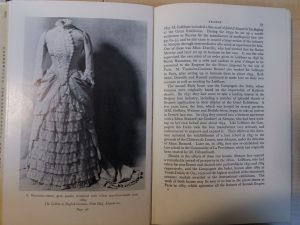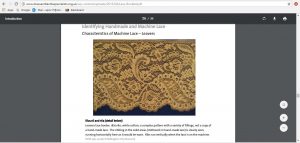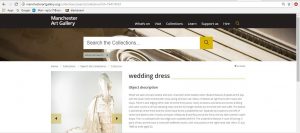I began my research by selecting a secondary source, a book from the library, which caught my attention. The book ‘Victorian Lace’ was written by Patricia Wardle and published in 1968 as part of a collector series. I was immediately inspired by the delicate floral lace patterns on the cover, so opened the book to select an image of a Victorian wedding dress which was trimmed with machine made lace made in 1884 (image 1a). To find a related object of a primary source I searched online for ‘Victorian lace’, however this gave me website pages for purchasing this style of lace and no details on the original production methods or characteristics of this material. Instead, I decided to change my search to ‘Victorian wedding dresses’ however this did not give me much information on the dresses themselves but more to do with the history of Victorian wedding ceremonies. Finally my search on ‘Victorian lace machine’ successfully linked me to an informative textiles website (http://www.dressandtextilespecialists.org.uk/wp-content/uploads/2015/04/Lace-Booklet.pdf) which held details of how to identify handmade and machine laces and also had some interesting pictures of textiles including a machine made lace sample from 1870-1880 (image 1b), the type which would have been used in the wedding dress I had found in the book, and provided some details on this. This website source was produced for The Museum of Costume and Textiles in Nottingham in collaboration with the V&A.
To find an archive to broaden my understanding of the dress and lace, I read further into the original book and noted where the dress was kept, then visited the website for Manchester Art Gallery (http://manchesterartgallery.org/collections/search/collection/?id=1947.4163) and found the dress listed on their site. The website gave me further information on measurements and construction methods of the wedding dress and also had some historical context and a higher resolution image which allowed me to see the details more clearly (image 1c).
Overall, I found the internet to be the most suitable place to find more detailed information; not only because using the internet is the most familiar way of researching for me, but also because by searching through such a broad area of information I could easily access what I needed to know and tailor my searches by specifying my search criteria. I did however find that the books in the library were more suitable for finding original inspiration and easily accessing details of interesting objects and artifacts together with information. I felt more involved and satisfied in this physical process of searching for inspiration in the yellowing pages of worn books than sat behind a computer screen with no inspiration around me to begin any creative process.



